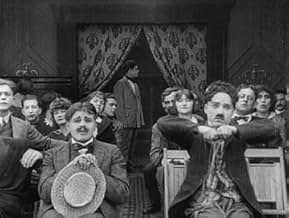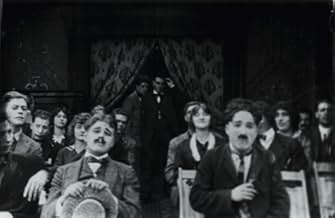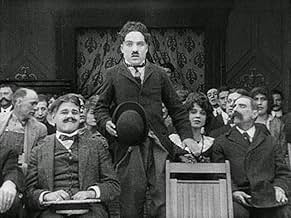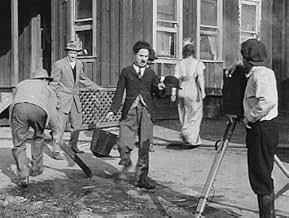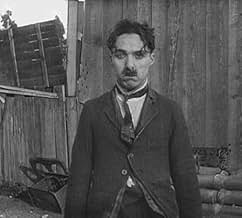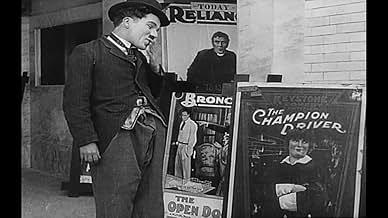CALIFICACIÓN DE IMDb
5.6/10
1.8 k
TU CALIFICACIÓN
Agrega una trama en tu idiomaCharlie attempts to meet his favorite movie actress at the Keystone Studio, but does not win friends there.Charlie attempts to meet his favorite movie actress at the Keystone Studio, but does not win friends there.Charlie attempts to meet his favorite movie actress at the Keystone Studio, but does not win friends there.
- Dirección
- Guionistas
- Elenco
Dan Albert
- Audience Member
- (sin créditos)
Hampton Del Ruth
- Lead Actor
- (sin créditos)
Minta Durfee
- Self
- (sin créditos)
- …
Billy Gilbert
- Theatre Usher
- (sin créditos)
William Hauber
- Audience Member
- (sin créditos)
Bert Hunn
- Audience Member
- (sin créditos)
George Jeske
- Prop Boy in White Shirt
- (sin créditos)
Edgar Kennedy
- Director
- (sin créditos)
Sadie Lampe
- Audience Member
- (sin créditos)
Henry Lehrman
- Self
- (sin créditos)
Hank Mann
- Prop Boy in Overalls
- (sin créditos)
Harry McCoy
- Fireman
- (sin créditos)
- …
George Nichols
- Older Actor on Screen
- (sin créditos)
- Dirección
- Guionistas
- Todo el elenco y el equipo
- Producción, taquilla y más en IMDbPro
Opiniones destacadas
Edgar English's work in this picture will keep it amusing. There are many good situations, fresh and laughable, and the offering ought to be welcome everywhere as a Tightener of the program. Camera work helps a lot. - The Moving Picture World, March 7, 1914
Charles Chaplin plays an overly infatuated film fan who decides to visit a movie theatre after seeing a gorgeous actress on the poster. In theatre, he causes quite a havoc before he gets thrown out. Afterward, he manages to get inside the movie studio where he sees the girl from the poster and movie. Well, you guessed it, more havoc is caused.
The theme of a fan falling in love with a starlet is interesting. The plot is easy to follow, even though some scenes seem quite randomly put together. The most interesting part to me was of course the look inside The Keystone Studios and to see how the films were made back in the day. Chaplin's Tramp was still just a trouble maker, but perhaps here some of the more recognizable traits are becoming visible.
Chaotic but still amusing movie. One of the best from the early works of Charles Chaplin.
If anyone has a question about what the title means then it is a play with the term "stage door Johnnie" which was used to describe people who hang out near the theatres in hopes of meeting actors or even land a job in the theatre.
The theme of a fan falling in love with a starlet is interesting. The plot is easy to follow, even though some scenes seem quite randomly put together. The most interesting part to me was of course the look inside The Keystone Studios and to see how the films were made back in the day. Chaplin's Tramp was still just a trouble maker, but perhaps here some of the more recognizable traits are becoming visible.
Chaotic but still amusing movie. One of the best from the early works of Charles Chaplin.
If anyone has a question about what the title means then it is a play with the term "stage door Johnnie" which was used to describe people who hang out near the theatres in hopes of meeting actors or even land a job in the theatre.
I love these early short comedies from Chaplin because, much more than most other directors early in their career, these early short films are such clear depictions of reality, there is always so much history to be seen in them. In Film Johnny, Charlie plays himself, basically, a newcomer to film, trying to get into the pictures and get noticed. But of course, in true Chaplin form, the only thing he manages to do is create havoc, botch an unnecessary rescue attempt and a make a mess of the studio.
My understanding is that "film Johnny" refers to the guys that would hang around film studios, hoping to get inside and get a job (it should be noted that Steven Spielberg used to do this). Chaplin starts out in this film as one of those guys, and then we see a clear escalation of the gags that they put together, culminating in a priceless scene where he gets his hands on a gun and gives in to the feeling of power and invincibility it gives him, and he goes around shooting up the place, famously lighting a cigarette by shooting it with the gun and then firing shots at random around the studio, eventually catching it on fire and inadvertently providing the perfect ending for the film that they had been trying to shoot while he was messing everything up.
It is also interesting, as I have noticed some other IMDb users have pointed out, that in this film you get a glimpse of the Keystone Studios lot only weeks after Chaplin began his film career. A must see for any fan.
My understanding is that "film Johnny" refers to the guys that would hang around film studios, hoping to get inside and get a job (it should be noted that Steven Spielberg used to do this). Chaplin starts out in this film as one of those guys, and then we see a clear escalation of the gags that they put together, culminating in a priceless scene where he gets his hands on a gun and gives in to the feeling of power and invincibility it gives him, and he goes around shooting up the place, famously lighting a cigarette by shooting it with the gun and then firing shots at random around the studio, eventually catching it on fire and inadvertently providing the perfect ending for the film that they had been trying to shoot while he was messing everything up.
It is also interesting, as I have noticed some other IMDb users have pointed out, that in this film you get a glimpse of the Keystone Studios lot only weeks after Chaplin began his film career. A must see for any fan.
According to some of the central figures involved, including Charlie Chaplin and producer Mack Sennett, Chaplin's first weeks making movies at the Keystone Studio were not pleasant ones. No one knew what to make of this temperamental young Englishman, while Chaplin, for his part, was bewildered by film technique and didn't get along with his colleagues. Though it may seem hard to believe now, there were serious doubts all around that Chaplin could make good in the movies.
Viewed in this light Chaplin's fifth comedy, A Film Johnnie, a fairly amusing short in its own right, takes on some additional historical weight as something of an inside joke, an indirect comment on Chaplin's actual off-screen status at his studio. In the opening sequence a scruffy-looking Charlie goes into a cinema and sees a Keystone comedy featuring an actress he admires. When her co-star, an older man, gets fresh with her Charlie becomes so upset and agitated he is ejected from the theater. He heads straight to the Keystone Studio, seeking to get in. (Thus the title: he's like the "stage door johnnies" who would hang around theaters, hoping to meet the performers and/or get a job with the acting company.) He watches as prominent performers such as Roscoe Arbuckle and Ford Sterling, wearing their street garb, step out of cars and casually enter the studio, smiling and chatting. They're members of the In Crowd, but he is not. Approaching a bemused Arbuckle, he requests and receives a hand-out. He tries this again with Sterling, but -- in a reflection of their alleged off-camera friction? -- receives nothing; Sterling even takes the coin Arbuckle had given Charlie earlier. The studio director (Edgar Kennedy) refuses Charlie admission, but he easily slips past the elderly doorman. Once inside he finds the girl he so admires (Virginia Kirtley) but ruins the scene she's acting in because he believes it's actually happening. He runs amok with a prop pistol, scaring everyone, then leaves.
The comic mayhem that occurs in the studio and at a nearby house fire --which might have been a real event-- amounts to routine Keystone knockabout, apparently improvised while the cameras were rolling. Charlie contributes some cute gags: he lights a cigarette by shooting it with a pistol, and starts to kick a stage hand but when the man turns he quickly switches to scratching his ankle. What's really of interest here is the context and the subtext: essentially Chaplin was still on probation when this film was made, and his colleagues' wariness towards him appears to be genuine. A Film Johnnie captures a time when Charlie hadn't made the grade, just yet.
Viewed in this light Chaplin's fifth comedy, A Film Johnnie, a fairly amusing short in its own right, takes on some additional historical weight as something of an inside joke, an indirect comment on Chaplin's actual off-screen status at his studio. In the opening sequence a scruffy-looking Charlie goes into a cinema and sees a Keystone comedy featuring an actress he admires. When her co-star, an older man, gets fresh with her Charlie becomes so upset and agitated he is ejected from the theater. He heads straight to the Keystone Studio, seeking to get in. (Thus the title: he's like the "stage door johnnies" who would hang around theaters, hoping to meet the performers and/or get a job with the acting company.) He watches as prominent performers such as Roscoe Arbuckle and Ford Sterling, wearing their street garb, step out of cars and casually enter the studio, smiling and chatting. They're members of the In Crowd, but he is not. Approaching a bemused Arbuckle, he requests and receives a hand-out. He tries this again with Sterling, but -- in a reflection of their alleged off-camera friction? -- receives nothing; Sterling even takes the coin Arbuckle had given Charlie earlier. The studio director (Edgar Kennedy) refuses Charlie admission, but he easily slips past the elderly doorman. Once inside he finds the girl he so admires (Virginia Kirtley) but ruins the scene she's acting in because he believes it's actually happening. He runs amok with a prop pistol, scaring everyone, then leaves.
The comic mayhem that occurs in the studio and at a nearby house fire --which might have been a real event-- amounts to routine Keystone knockabout, apparently improvised while the cameras were rolling. Charlie contributes some cute gags: he lights a cigarette by shooting it with a pistol, and starts to kick a stage hand but when the man turns he quickly switches to scratching his ankle. What's really of interest here is the context and the subtext: essentially Chaplin was still on probation when this film was made, and his colleagues' wariness towards him appears to be genuine. A Film Johnnie captures a time when Charlie hadn't made the grade, just yet.
Shot very early in Chaplin's film career, A Film Johnny (I have no idea what the title means) is a short, but fascinating look at how movies were made in the earliest days of Hollywood.
Unfortunately, the DVD version I saw was a 1930s reissue edit that, for some reason, omits the prologue in which Chaplin decides to visit a movie studio after falling for a girl on the screen. But what remains is a fast-paced, sometimes confusing montage of scenes in which the Little Tramp (fast developing into the character the world would come to love) basically causes havoc at the real-life Keystone Studios.
Reportedly, Mack Sennett and Fatty Arbuckle and even Mabel Normand appear in the film. I think I spotted Sennett, but I have no idea what role Arbuckle played, while Normand was nowhere to be seen (though she might be the girl seen laughing at Charlie at the end). But as I saw a shortened version, it's possible their scenes were simply cut out.
What does survive is a very funny (and innovative) gag in which Chaplin lights a cigarette by firing a gun loaded with blanks at it. That, plus a fleeting glimpse of the Keystone Studios mere weeks after Chaplin began his movie career, makes this worthwhile. Chaplin's later film, Behind the Screen, another movie lot comedy, is a much better film, however.
Unfortunately, the DVD version I saw was a 1930s reissue edit that, for some reason, omits the prologue in which Chaplin decides to visit a movie studio after falling for a girl on the screen. But what remains is a fast-paced, sometimes confusing montage of scenes in which the Little Tramp (fast developing into the character the world would come to love) basically causes havoc at the real-life Keystone Studios.
Reportedly, Mack Sennett and Fatty Arbuckle and even Mabel Normand appear in the film. I think I spotted Sennett, but I have no idea what role Arbuckle played, while Normand was nowhere to be seen (though she might be the girl seen laughing at Charlie at the end). But as I saw a shortened version, it's possible their scenes were simply cut out.
What does survive is a very funny (and innovative) gag in which Chaplin lights a cigarette by firing a gun loaded with blanks at it. That, plus a fleeting glimpse of the Keystone Studios mere weeks after Chaplin began his movie career, makes this worthwhile. Chaplin's later film, Behind the Screen, another movie lot comedy, is a much better film, however.
¿Sabías que…?
- TriviaAlthough some sources credit Mack Sennett with playing himself, the film director, the role is actually played by Edgar Kennedy--who, besides being a comic actor, was also a respected director.
- ErroresMembers of the audience behind Charlie Chaplin change - for example, Minta Durfee is sitting behind Chaplin in some shots, but a different actress is seated behind him in others.
- Versiones alternativas1930s reissue version, entitled Film Johnny, (released on DVD) omits the opening sequence in the movie theater.
- ConexionesFeatured in Crazy Days (1962)
Selecciones populares
Inicia sesión para calificar y agrega a la lista de videos para obtener recomendaciones personalizadas
Detalles
- Fecha de lanzamiento
- País de origen
- Sitios oficiales
- Idiomas
- También se conoce como
- Charlie the Actor
- Locaciones de filmación
- Bryson Apartments, 2701 Wilshire Blvd., Los Ángeles, California, Estados Unidos(Apartment Building)
- Productora
- Ver más créditos de la compañía en IMDbPro
- Tiempo de ejecución
- 15min
- Color
- Mezcla de sonido
- Relación de aspecto
- 1.33 : 1
Contribuir a esta página
Sugiere una edición o agrega el contenido que falta

